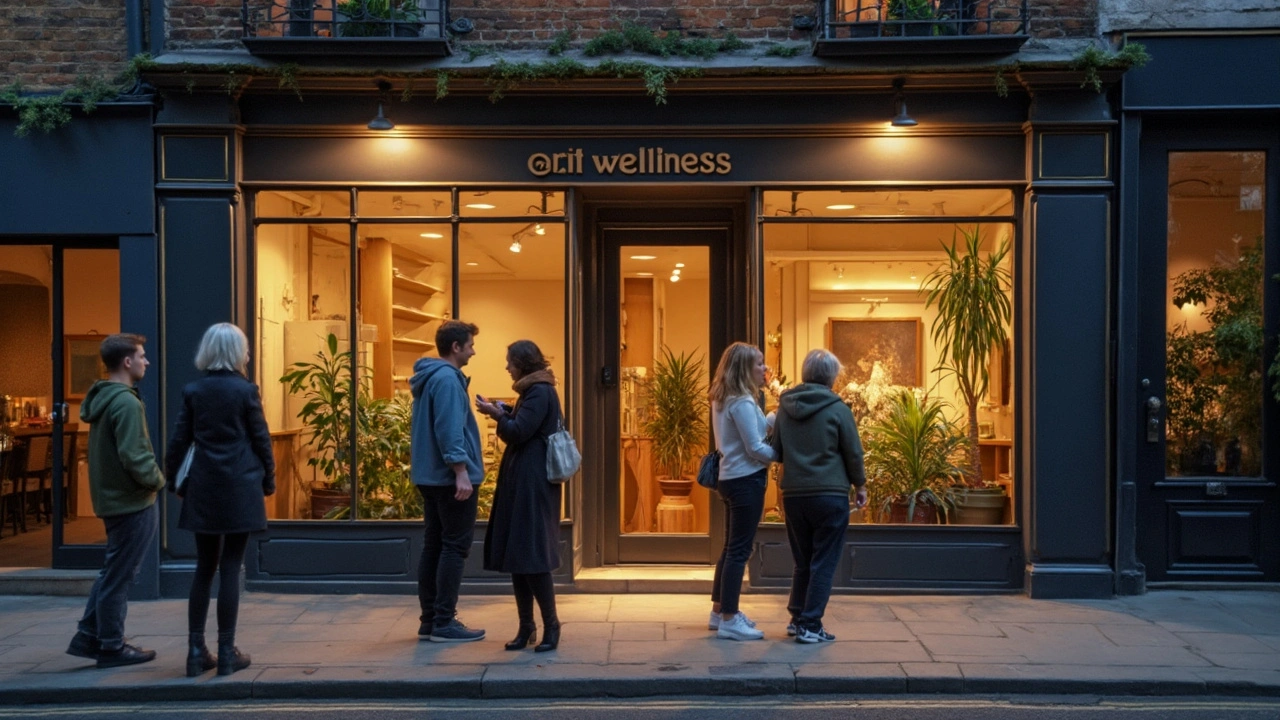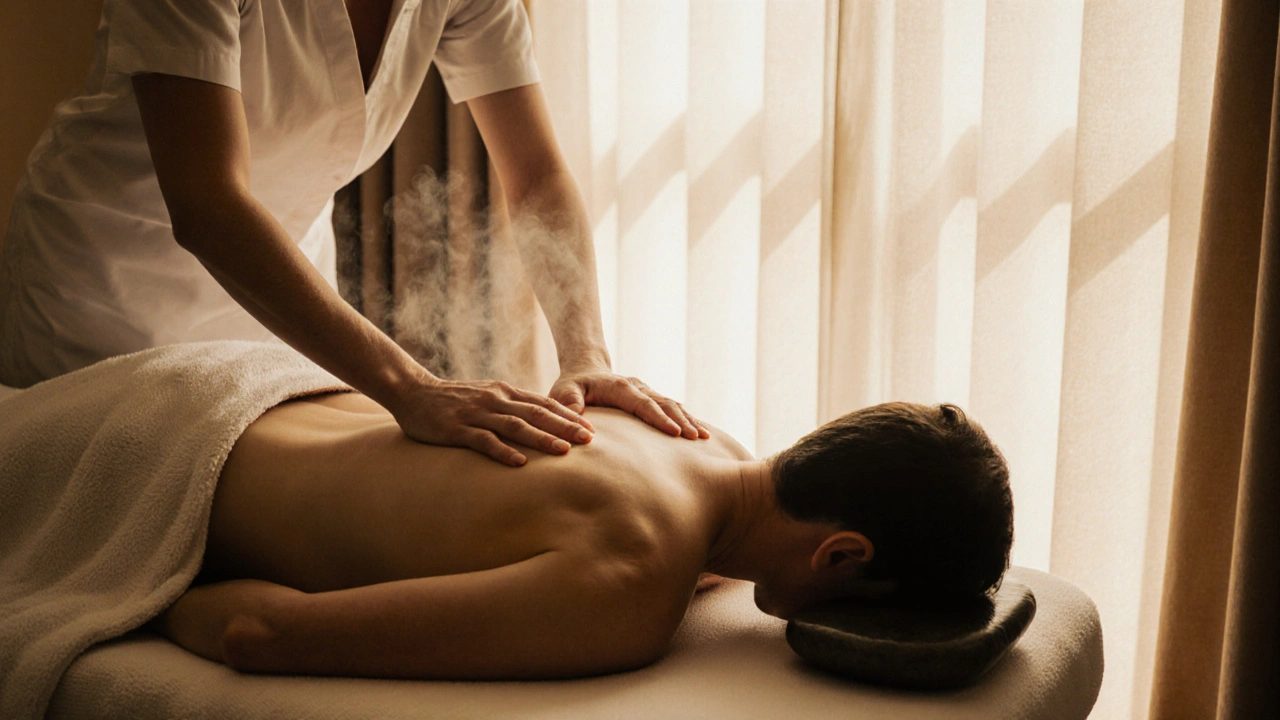Discover how aromatherapy massage can lend your immune system a helping hand. This article breaks down how scented oils and expert hands work together to support your health. You’ll get clear tips, learn the science, and find out what to expect from a session. Whether you’re curious or ready to book, you’ll walk away knowing exactly why this self-care ritual is more than just pampering. Real talk, real benefits—no fluff.

- Created by: Archer Caldwell
- Completed on: 5 Jul 2025
- Categories: Wellness
Key Points: Fast Facts About Massage Therapy
- Massage therapy offers unique benefits for mind and body, from stress relief to pain management.
- You’ll find many types of massage, such as Swedish, deep tissue, hot stone, and more.
- Sessions usually last 30 to 90 minutes, tailored to your preferences and health needs.
- Prices vary by technique, session length, and local demand; expect anywhere from $60 to $150 per hour in most urban areas.
- Always check for licensed therapists and clear hygiene practices for a safe, positive experience.
Direct Answer: How Does Massage Therapy Work?
A massage therapist uses skilled hands, targeted pressure, and thoughtful movement to relax your muscles, ease pain, boost blood flow, and lift your mood. By working specific areas, they help release tension you didn’t even realize you were holding. Above all, it’s about creating a comfortable space where your body can heal itself a little more with every touch.
Comprehensive Guide to Massage Therapy: The Healing Touch Up Close
Picture walking into a room that instantly hushes the outside world. There’s something about that soft music, low lights, and fresh scent of essential oils that just tells your brain, “Hey, you can relax now.” That’s the magic setting the stage for a session with a skilled massage therapist. Most folks think massage is just about working sore muscles, but there’s a bigger story. Massage therapy has been around for thousands of years, and it still holds strong as one of the best ways to melt away daily stress and reset both physically and emotionally. You know those times you catch yourself hunched over your laptop, jaw tight, shoulders nearly touching your ears? Massage goes after that built-up tension—sometimes in places you never knew were tense in the first place.
According to the American Massage Therapy Association (AMTA), more than 47.5 million Americans got at least one massage last year. That’s not just people looking for pampering; it’s athletes, desk-bound workers, parents, and anyone facing life’s grind. The stats back it up, too. Studies published in journals like the International Journal of Neuroscience show that massage can drop your heart rate, lower blood pressure, and even boost immune function. That's pretty wild for something that feels this good. Some sessions are all about slow, flowing strokes called Swedish massage, while others go deep, digging into stubborn knots with targeted pressure. There’s even special work for headaches, prenatal needs, or sports injuries.
As someone who’s always running after my kid Finley, juggling deadlines, and trying to keep household chaos in check with Isabella, I can vouch for how a single therapy session can turn a whole mood around. There’s something about letting go for an hour—maybe dozing off a bit—while someone else works on the everyday aches you collect just living life. It's like hitting a mental and physical reset button you always forget you need until you get it. More and more, people are realizing it’s not a luxury; it’s part of real self-care. And let’s face it, in 2025, when so much of life feels stressful or glued to a screen, touch has never felt more powerful.
Definition and Context: What Is Massage Therapy—and Why Does It Matter?
Massage therapy is pretty simple at its heart: a trained professional uses pressure, movement, and a set of techniques to manipulate the muscles and soft tissue of your body. But that definition skips the real magic—how it actually feels to have someone tune in and focus on what your body needs. Different cultures have their own spin on it, too. Some put their twist on techniques that have been refined for centuries, like Thai massage, which incorporates stretching and movement, or Japanese shiatsu, focusing on finger pressure along energy lines.
Why does this matter, though? Because most of us carry stress like a badge of honor, turning it into headaches, sleep issues, or chronic pain. The therapist’s work triggers your body’s relaxation response, which calms your nervous system and lets your muscles loosen up. Even your gut can benefit—goodbye stress belly. We see more doctors referring patients to massage for everything from recovered muscle injuries to managing anxiety. One interesting bit: some insurance plans in the U.S. now cover therapeutic massage, especially if prescribed for things like chronic pain or rehabilitation. That’s a pretty big change from the days when it was treated as pure pampering. There's even a quote from Dr. Mark Rapaport, chair of psychiatry at Emory University School of Medicine, who said,
“Massage isn’t just about feeling good in the moment. Regular sessions can produce real changes in how our bodies and minds work together.”
Many therapists get formal training, often with several hundred hours of practical experience, plus accreditation in states that require a license. This isn’t a quick learn-on-the-job skill. Massage professionals usually have a deep understanding of anatomy and the science behind pain and relaxation—so they know how to keep things safe and effective. There’s a strong code of ethics, too, focused on boundaries and respect at every stage of the session. You’re always in control, and you can let your therapist know exactly what feels good or when something’s uncomfortable. If it ever feels awkward or unsafe, that’s a sign to speak up or walk out.
Benefits of Massage Therapy: More Than Just Relaxation
Ask anyone who just walked out of a great massage and they’ll probably say, “I feel like a whole new person!” But what’s really going on under the skin? First, massage therapy is famous for wiping away muscle tension. Seriously, you’ll walk out feeling looser, lighter, and ready to move again. Beyond that, the big news is the mental benefits. The American Psychological Association says that massage can help lower levels of cortisol, the hard-working stress hormone linked to anxiety, depression, and immune issues. Your mood gets a legitimate boost, in part because of the “feel good” neurotransmitters—like serotonin and dopamine—released during a session.
Doctors and physical therapists often recommend massage as part of a treatment plan for injuries, whether it’s from sports or just sleeping wrong for the fourth night in a row. Want to know something surprising? Regular massage can help promote faster recovery after workouts and soothe inflamed muscles. A 2024 article in the Journal of Sports Rehabilitation found that athletes who received two massages per week during training seasons had 30% fewer injuries. Impressive, right?
For folks struggling with chronic issues like migraines or fibromyalgia, massage sessions help take the edge off those constant aches. And for people like my wife, who juggles family, work deadlines, and endless multitasking, the mental reboot is huge. After a rough week, Isabella always comes home from her Saturday session looking like she just spent a weekend at an island spa. There’s no magic wand, but for a lot of us, massage is the next best thing.
Here’s a quick table comparing some common benefits people report with regular sessions, based on a national survey published by AMTA in April 2025:
| Benefit | Reported by Clients (%) |
|---|---|
| Reduced muscle tension | 88 |
| Improved relaxation | 85 |
| Pain relief | 67 |
| Better sleep | 62 |
| Headache reduction | 53 |
If you’re tired of popping Advil after long days or want to tackle anxiety in a gentle, hands-on way, massage therapy could honestly change the game.
Types of Massage Therapy Available Near You
Here's the fun part: not every session is the same. In most cities, even small towns, you’ll come across at least four or five styles of massage. The classic is Swedish massage. It focuses on slow, fluid motions, gentle kneading, and soothing your entire body. Perfect if you’re new or just need to zone out. Next is deep tissue, which, as the name says, goes deeper—this one’s for those stubborn knots and muscle pain that just don’t quit. It might be intense, but in the “hurts so good” kind of way. If you’re a gym rat or marathon runner, sports massage tailors its moves to active muscles, targeting recovery and flexibility.
Hot stone massage layers in heat therapy, using warm stones placed on your body to melt tension in a way that just hands can’t do alone. Reflexology, which focuses on pressure points in the hands and feet, claims to send healing signals throughout your whole body. Prenatal massage gets a lot of love too, making pregnancy aches less overwhelming while keeping things extra safe for both mom and baby. Curious about something a little more out there? Some places offer Thai massage, which blends assisted stretching with massage, leaving you feeling like you’ve just finished a private yoga class.
Let’s list a few more you might see on a local menu (and what they’re best for):
- Shiatsu: Rhythmic finger pressure on energy lines; popular for stress and fatigue.
- Trigger Point Therapy: Isolates and works muscle knots; good for chronic pain.
- Lymphatic Drainage: Gentle strokes to help reduce swelling and promote detox.
- Aromatherapy Massage: Uses essential oils for added relaxation or mood-boosting effects.
Pro tip: Don’t hesitate to ask your therapist about the different types. They usually love explaining what each session involves, and they can guide you to the right pick if you’re looking for specific results—like better sleep or relief from that annoying crick in your neck.

How to Find the Right Massage Therapist
If you’ve never booked a session before, the choices can feel overwhelming. Here’s a quick breakdown to make it simple:
- Start with local reviews—sites like Google, Yelp, and even community Facebook groups are gold mines for honest feedback.
- Look for therapists who are licensed and certified in your state. Most will display certifications online, or there’s usually a state database you can check.
- Don’t skip the website or online booking system. Professionalism matters—clean photos, detailed service menus, and clear booking steps all signal a reliable business.
- Pop by in person if you can. You can feel the vibe—and if something seems off, trust your instincts. Comfortable spaces matter more than you’d think.
In bigger cities, you’ll find everything from day spas and wellness clinics to independent therapists with cozy studios. Some will specialize in sports or injury recovery, while others focus on day-to-day relaxation. If you have a specific condition, like chronic pain or pregnancy, let your therapist know upfront. They’ll talk through your goals and health history, then recommend the best approach. Never feel shy about asking questions or clarifying boundaries. Your comfort is key—always.
You can always search for “massage therapist near me” to see what pops up, but take that next step and read some reviews. Look for mentions of cleanliness, communication, and how the therapist made people feel. Word of mouth never goes out of style, either—the best tip I got came from a tired dad at school pickup who raved about his go-to therapist.
What to Expect During a Massage Session
Nerves before your first session? Totally normal. Knowing what to expect makes everything easier. You’ll usually start with a quick chat where you talk about any aches, pains, or health issues—don’t hold back. The therapist will step out so you can undress to your comfort level and get onto the table (pro tip: you’re always covered with a sheet except for the area being worked on). Every move, from where the therapist starts to the pressure they use, is tailored to what you’ve shared.
The room is usually warm but not stifling, with low lighting, soft music, and that telltale hint of lavender or eucalyptus. Expect the therapist to check in a few times—“How’s the pressure?” or “Is this spot okay?” Speak up! This session is all about you. If you want them to skip your feet or focus more on your back, just say it. Most sessions stick to 60 or 90 minutes, but you can book as little as half an hour if you’re pressed for time or want to dip your toe in. You can chat the whole time or totally zone out. I sometimes use the hour to unplug and not say a single word unless I need a blanket or a little less pressure on a tender spot.
During and after the massage, it’s not unusual to feel warmth in target muscles, occasional tingling, or even a mild emotional release. Some folks get drowsy; others hop off the table with a “ready-to-run-a-marathon” vibe. No wrong reactions here. Afterward, drink plenty of water; your body’s flushing out toxins released during the session. It’s common to feel lighter, clearer, and—in my case—even a little taller as you walk out the door.
Pricing, Booking, and Safety Tips
Let’s be real—cost matters. Prices for massage therapy are all over the map, depending on where you live, what style you pick, and how long your session lasts. In most U.S. cities in 2025, expect to pay:
| Session Length | Typical Price (USD) |
|---|---|
| 30 minutes | $45-$70 |
| 60 minutes | $80-$120 |
| 90 minutes | $120-$160 |
Hot stone and specialty massages usually add $20-$40 per session. Tipping is customary (around 15-20%), though always optional. Most booking is online these days—just find your therapist’s site, pick your slot, and handle payment by card to keep things easy and safe. Many therapists now text appointment reminders or offer contactless payment for extra convenience. If you have a Health Savings Account or insurance, see if you can use it for therapeutic sessions—more plans are covering this each year.
Safety is a big deal. Look for clean spaces, fresh linens, and therapists who wash their hands in front of you. If you have a medical issue like a blood clot, infection, or recent surgery, let your therapist know before booking. For pregnancy, always find someone certified in prenatal massage. Never ignore your gut. If anything feels wrong—too much pain, awkward comments, or sketchy behavior—leave immediately. Your comfort and health come first, always.
Massage Therapy vs. Physical Therapy: Which One’s Right for You?
| Feature | Massage Therapy | Physical Therapy |
|---|---|---|
| Main Focus | Muscle relaxation, pain management, stress relief | Injury rehab, mobility, restoring function |
| Practitioner | Licensed Massage Therapist (LMT) | Licensed Physical Therapist (PT) |
| Typical Session | Table, soothing setting, hands-on work | Exercises, stretches, hands-on plus equipment |
| Best For | Tension, chronic stress, muscle pain | Post-surgery, major injury, severe mobility issues |
| Referral Needed? | No | Usually Yes |
FAQ: Your Questions About Massage Therapy Answered
- Is massage therapy safe for everyone?
Usually, yes—but folks with certain conditions (like blood clots, severe osteoporosis, or infections) should check with a doctor first. - Do I need to get undressed?
Only to your comfort level. You’ll always be covered except for the area being worked on. - How often should I get a massage?
Totally up to you. Monthly is common, but weekly or biweekly helps more for ongoing pain or stress. - Will massage therapy hurt?
Sometimes, deep tissue work is a bit uncomfortable, but you should never feel real pain. Tell your therapist if it’s too much. - Can I book a massage for my child or teen?
Yes! Many therapists see kids, but check for special training and always stay present for their session.
Ready to Relax?
Your body gives you more signals than your phone ever will—so it’s worth listening. If the daily grind leaves you feeling off, tight, or on edge, massage therapy might be the gentle fix you’ve needed but never stopped long enough to try. Check out a local therapist, support small business, and give your muscles (and mind) a little peace.
Looking for ultimate relaxation in East London? This guide explores the city's top massage spots, breaks down the benefits of different treatments, and shares tips on finding the right service for you. You'll discover what actually happens during a session, the best ways to book, and how to ensure safety. Expect real-life examples, amusing facts, and answers to frequently asked questions. Get ready to unwind, de-stress, and enjoy the peace you deserve.
Discover how full body massage improves flexibility and mobility by releasing deep muscle tension and fascial restrictions. Learn what to expect, how to find the right therapist in London, and why it works better than stretching alone.



